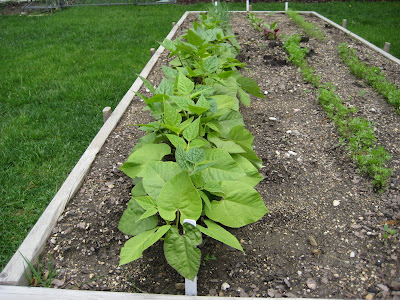
With all the hoopla surrounding the release of the new movie "Julie & Julia", I thought it only fitting to jump on the Blogger Bandwagon with my two cents. Wouldn't want my blog to miss any Google hits. I guess this makes me guilty of using Julia's name and reputation to get ahead, something she would have frowned upon. But hey, everybody is doing it, so that makes it alright, n'est-ce pas?
Don't get me wrong, I am a HUGE Julia Child fan. She has been my hero since I was a small child. I remember watching the French Chef series in the mornings along with Sesame Street and Mr. Rodger's Neighborhood back in the early 70's. I firmly believe that she is responsible for my love affair with fine food. She inspired me to cook, and to become a Chef. She taught me to be an undying Francophile, as she was. I love her, and I always will. I am thrilled that they actually made a movie about her. I saw the movie, and I absolutely loved it! But I love all things Julia. I always have. She deserves this recognition because she completely changed the way that Americans ate. Notice that I say ATE, not EAT. All of the great progress that Julia inspired in the 60's and 70's has been undermined by the glut of corporate/fast food/Food Network crap of the 80's, 90's, and 2000's. But I'm getting ahead of myself...
Julia Child was a Purist. She believed in good, honest hard work, and everything in moderation. She loved food, and she loved French food most of all. She is the perfect anti-hero for today. She did not peak at 25 years old and make millions by selling out. She did not even learn to cook until she was 37 years old (practically dead by today's standards). She was not youthful, she was not glamorous or graceful, she didn't have a great TV personality, but she had passion and the courage of her convictions. This is sadly the one quality that is missing from today's "Stars". There is no passion for food, only sales and competition. Julia would be absolutely mortified at what the "Celebrity Chef" has degenerated into, a cheap pitch person for merchandise. A talking head with absolutely no food sense whatsoever. She would be shocked to see Gordon Ramsey risk Michelin Stars for ratings.
Julia never lent her name to any merchandise, only her books and television series. Julia never lent her name or endorsements to other cookbooks. She did not want to have her name exploited by the mass media marketing machine. She knew the dangers of allowing money mongers to get their cold, corporate hands on her art. She was a true artist, living only to cook her beloved French Cuisine for her beloved husband, and for us. A true gift.
According to Sarah Moulton, who was lucky enough to be mentored by Julia Child,
Julia absolutely HATED the Julie/Julia Blog. She thought it was gimmicky and exploited her name and reputation. This was the attitude that Julia had towards most people that tried to pay her homage. She wanted none of it. She wasn't a saint, she was a teacher. She worked hard and wanted others to work hard too. There was no time for platitudes, only food. And make that French food, thank-you! The greatest food of all!
Yes, Julia Child loved La France. From the moment she tasted the Sole Meuniere at
La Couronne in Rouen, she knew that she was home. She knew what her life's mission was - to teach Americans to adore the treasures of the French table. This is the Julia Child of my experience. The teacher absolutely brimming with all things French. As I watched her as a child, I knew that she spoke the truth. She made me want to be French, like she wanted to be French. Today I like to say : Je suis Americain, mais mon coeur et Francais (I am American, but my heart is French). This was how she felt. She loved America, but her heart and soul were French.
And it worked! America fell madly in love with this strange creature who wasn't afraid to give it her all. Her passion for La Cuisine Francaise was greater than her lack of perfection. She was like us, imperfectly human. When she dropped something, she picked it up and kept going. Fearless! She became so popular that she made the cover of Time Magazine's Thanksgiving issue in 1966.
Her passion continued for the rest of her life. She worked tirelessly to teach Americans the Art of French Cooking. She inspired a whole generation of new Chefs to cook from the heart. She changed the way that Americans ate. Besides winning many TV and literary awards, and an honorary doctorate from Harvard, Julia Child was also presented with the Legion of Honor by her beloved France in 1991. She was presented with the Medal of Freedom by the United States in 2003, the highest civilian honor.
So what happened? Why has our Food Culture degenerated to the point that there is a Panera on every corner, and a real bakery can't make it? Why as a nation do we consider going to the drive thru at McDonalds a suitable option to feed our children a "meal"? Why do we attempt to ban foie gras, but cigarettes are legal? Why is there E-coli on my Enoki mushrooms? Why are we considering legislation to make it illegal to criticize monster food conglomerates for their crimes against nature and humanity? What the hell is going on in this country?
We have become divorced from the notion that
GOOD FOOD = PLEASURE!!!
We are so hung up on convenience that we have sold our health and the health of our children for our hectic schedules. We run around like idiots, from work, to school, to soccer practice, to activity after activity, but we don't stop to eat as a family. When we are finally at home together, we go off into our own isolated/electronic worlds: IPod, Texting, Cell Phone, Video Games, IPhone Apps, Web Surfing, etc... How many times do you have to tell your kids NOT to text at the dinner table? We are drifting apart as families and as a nation. The once strong bond of the dinner table has been replaced by grabbing a bucket of calorie laden "food" on the way from soccer practice to Hip Hop dance practice. It's nuts!
And the corporations are there to make it all possible. We have returned to the America that Julia Child faced when she was first starting out. The America of the Frozen Dinner. The America where having to be in the kitchen was seen as some kind of Draconian punishment. Only now it's worse because there are even more "choices". We can feed ourselves for very little money and very little time. Sounds great, but look at the consequences: obesity, diabetes in children, heart disease, cancer, cancer, cancer, sexually mature 8 year olds (from hormones), powerful new strains of E-coli, genetically modified organisms, irradiation, pollution, and Paula Deen - who is the spokesperson for Smithfield Foods, one of the biggest polluters on EARTH!
Shame on you, Paula! Did you do any research at all, or do Y'ALL only care about money???
I think that America needs Julia Child, now more than ever! We need her to teach us again. We need to STOP and LISTEN. The release of Julie & Julia has the potential to introduce a whole new generation of young Americans to the Grande Dame of French Cuisine. When I went to the movie, the theatre was PACKED! I actually had to wait in a huge line because so many people wanted to see Julia again. I found it very encouraging. It's not too late, we can still get this right. We just need to turn off the Food Network and listen to someone who actually loved food!
I love you, Julia! You are my HERO. Thank-you for teaching me to love La Cuisine. I miss you.
Bon Appetite!





























































